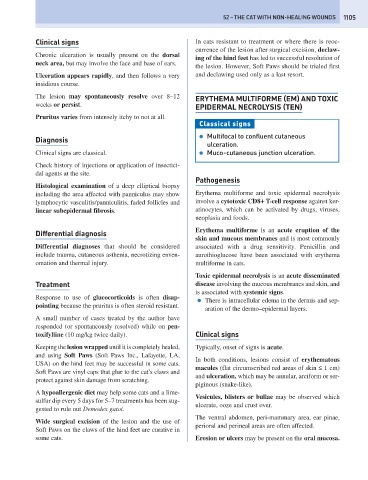Page 1113 - Problem-Based Feline Medicine
P. 1113
52 – THE CAT WITH NON-HEALING WOUNDS 1105
Clinical signs In cats resistant to treatment or where there is reoc-
currence of the lesion after surgical excision, declaw-
Chronic ulceration is usually present on the dorsal
ing of the hind feet has led to successful resolution of
neck area, but may involve the face and base of ears.
the lesion. However, Soft Paws should be trialed first
Ulceration appears rapidly, and then follows a very and declawing used only as a last resort.
insidious course.
The lesion may spontaneously resolve over 8–12 ERYTHEMA MULTIFORME (EM) AND TOXIC
weeks or persist. EPIDERMAL NECROLYSIS (TEN)
Pruritus varies from intensely itchy to not at all.
Classical signs
● Multifocal to confluent cutaneous
Diagnosis
ulceration.
Clinical signs are classical. ● Muco-cutaneous junction ulceration.
Check history of injections or application of insectici-
dal agents at the site.
Pathogenesis
Histological examination of a deep elliptical biopsy
including the area affected with panniculus may show Erythema multiforme and toxic epidermal necrolysis
lymphocytic vasculitis/panniculitis, faded follicles and involve a cytotoxic CD8+ T-cell response against ker-
linear subepidermal fibrosis. atinocytes, which can be activated by drugs, viruses,
neoplasia and foods.
Erythema multiforme is an acute eruption of the
Differential diagnosis
skin and mucous membranes and is most commonly
Differential diagnoses that should be considered associated with a drug sensitivity. Penicillin and
include trauma, cutaneous asthenia, necrotizing enven- aurothioglucose have been associated with erythema
omation and thermal injury. multiforme in cats.
Toxic epidermal necrolysis is an acute disseminated
Treatment disease involving the mucous membranes and skin, and
is associated with systemic signs.
Response to use of glucocorticoids is often disap-
● There is intracellular edema in the dermis and sep-
pointing because the pruritus is often steroid resistant.
aration of the dermo–epidermal layers.
A small number of cases treated by the author have
responded (or spontaneously resolved) while on pen-
toxifylline (10 mg/kg twice daily). Clinical signs
Keeping the lesion wrapped until it is completely healed, Typically, onset of signs is acute.
and using Soft Paws (Soft Paws Inc., Lafayette, LA,
In both conditions, lesions consist of erythematous
USA) on the hind feet may be successful in some cats.
macules (flat circumscribed red areas of skin ≤ 1 cm)
Soft Paws are vinyl caps that glue to the cat’s claws and
and ulceration, which may be annular, arciform or ser-
protect against skin damage from scratching.
piginous (snake-like).
A hypoallergenic diet may help some cats and a lime-
Vesicules, blisters or bullae may be observed which
sulfur dip every 5 days for 5–7 treatments has been sug-
ulcerate, ooze and crust over.
gested to rule out Demodex gatoi.
The ventral abdomen, peri-mammary area, ear pinae,
Wide surgical excision of the lesion and the use of
perioral and perineal areas are often affected.
Soft Paws on the claws of the hind feet are curative in
some cats. Erosion or ulcers may be present on the oral mucosa.

